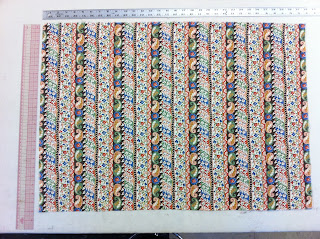Recycle your fabrics!
Okay, this is an obvious one, and most costumers and home crafters already do this. For our recent production of
The Comedy of Errors, we looked to the fabric wall (see below) to supplement what we bought in the store. I am confident (and super proud) that this helped s to come
under budget! Most of our shopping was done at our local fabric warehouse, and pulling some special, more expensive pieces from stock really helped make the costumes look expensive and unique.
Here you can see our fabric wall in the shop. There are a few fabrics that are located in our costume stock as they have yardages that just won't fit on these shelves. This is not an extensive collection when you consider the number of years we have operated, but it is well-organized and so can be looked through easily and hopefully used often.
The rules are: sort fabrics by color first and perhaps by type; fur, leather/vinyl/microsuede, sheers, laces, beaded and sequined, velvets, knits are all kept in separate boxes; anything over 1 yard is saved on the wall; anything under 1 yard, but pricey or truly interesting), is organized into a box by type (fancy fabrics, cottons, wools) and then color (light/pale, medium, dark/bright tones). We have storage for left-over trims and buttons, too.
We sort and purge our wall once per year. Anything unwanted, we try to donate to a local school for use in their art and theater departments.
Also, see this lovely article for great ideas on how to use up your fabric stash.
http://www.embtreasures.com/articles/UnwantedFabric.htm
Also, we have been using quite a bit of yardage to make storage items for stock: hanging shelves for hats and slipcovers for wedding dresses and other delicate items.
Lately, though, perhaps inspired by the western theme of
Comedy or by my empty wallet, I have been exploring some homesteading options to use up all of those scraps that inevitably end up in the trash. You know, all those little triangles and bits. I think back to the Victorian crazy-quilt on my parent's bed: exquisitely pieced together, and totally beyond my skill or comprehension. But I am willing to try some smaller quilts--can you say dollhouse? Also willing to explore paper-making. I seem to recall seeing shredded fabric put into the pulp used to make homemade paper, but I can't find anything about this.
Here is one tutorial for making "fabric paper" by gluing and layering fabric, tissue paper, and small items like dried flower petals (hey! that's recycling, too! for those of us who receive flowers, that is).
http://www.squidoo.com/FannieFabricPaper
My favorite idea so far? Making
beads out of fabric scraps. Yes, BEADS! Big statement jewelry has been popular for a while now, and can be expensive (what is your time worth?). Check this out:
http://www.ehow.com/how_6357681_instructions-necklace-using-round-beads.html
If anyone tries any of these, please post your results! I hope to create some things for the holidays and keep my trash can free of those fabric scraps!






















